Hưởng Niềm Vui Do Thiền Định – Tasting the joy of Meditation – Song ngữ
English: Ajahn Chah.
Việt ngữ: Phạm Kim Khánh.
Compile: Lotus group.

Hưởng Niềm Vui Do Thiền Định – Tasting the joy of Meditation

Niệm (Sati) chỉ là sự hiện hữu của tâm. Đó là nguyên
nhân làm phát sanh trạng thái tự hay biết mình và trí tuệ …
Dầu trong khi không nhập định (samàdhi), luôn luôn phải giữ
chánh niệm….”
“… That which “looks over” the various factors which arise in meditation is ‘sati’, mindfulness. Sati is life. Whenever we don’t have sati, when we are heedless, it’s as if we are dead…. This sati is simply presence of mind. It’s causes for the arising of self-awareness and wisdom…. Even when we are no longer in samàdhi, sati should be present throughout….”
“…Cái gì bám sát “theo dõi” những yếu tố tâm khác nhau phát sanh trong khi hành thiền là “niệm” (sati). Sati là cả cuộc sống. Mỗi khi ta thất niệm, không có sati, khi ta dể duôi lơ đễnh, là cũng giống như đã chết … Niệm chỉ là sự hiện hữu của tâm. Đó là nguyên nhân làm phát sanh trạng thái tự hay biết mình và trí tuệ … Dầu trong khi không nhập định (samàdhi), luôn luôn phải giữ chánh niệm….”
About this mind…
Về cái tâm nầy…
In truth there is nothing really wrong with it. It is intrinsically pure. Within itself it’s already peaceful. That the mind is not peaceful these days is because it follows moods. The real mind doesn’t have anything to it, it is simply (an aspect of) Nature. It becomes peaceful or agitated because moods deceive it.
Trong thực tế không có gì thật sự là sai lầm. Bản chất cố hữu dính liền với nó là trong sạch. Do bản tánh thiên nhiên, tự nó là thanh bình an lạc. Sở dĩ ngày nay tâm không được an lạc là bởi vì nó mãi chạy theo những cảm xúc thương, ghét, buồn, vui, của đời. Cái tâm chân thật không có gì là vui buồn hay thương ghét mà đơn giản chỉ là một sắc thái của Thiên Nhiên. Tâm trở nên an lạc hay chao động vì bị cảm xúc lường gạt.
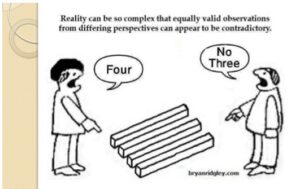
The real mind doesn’t have anything to it, it is simply
(an aspect of) Nature. It becomes peaceful or agitated because
moods deceive it.
The untrained mind is stupid. Sense impressions come and trick it into happiness, suffering, gladness and sorrow, but the mind’s true nature is none of those things. That gladness or sadness is not the mind, but only a mood coming to deceive us. The untrained mind gets lost and follows these things, it forgets itself. Then we think that it is we who are upset or at ease or whatever.
Một cái tâm không được rèn luyện quả thật là khờ dại. Cảm thọ do giác quan đưa đến phỉnh lừa, đưa nó vào những trạng thái hạnh phúc, đau khổ, thỏa thích, hay âu sầu phiền muộn, nhưng bản chất thật sự của tâm thì không có gì như vậy. Trạng thái thỏa thích hay âu sầu ấy không phải là tâm mà chỉ là những cảm xúc, đến để lừa đảo phỉnh gạt chúng ta. Một cái tâm không được rèn luyện sẽ lạc lối và bám sát theo những xúc cảm buồn vui thương ghét ấy và tự quên mình. Rồi ta nghĩ rằng chính ta băn khoăn lo ngại, hoặc dễ chịu thoải mái, hoặc gì khác.
But really this mind of ours is already unmoving and peaceful… really peaceful! Just like a leaf which is still as long as no wind blows. If a wind comes up the leaf flutters. The fluttering is due to the wind — the “fluttering” is due to those sense impressions; the mind follows them. If it doesn’t follow them, it doesn’t “flutter.” If we know fully the true nature of sense impressions, we will be unmoved.
Nhưng trong thực tế tâm vốn không chao động mà thanh bình … thật sự an lạc! Giống như chiếc lá cây nằm im khi không có gió. Ngọn gió thoảng qua, lá liền chao động. Lá chao động vì gió — trạng thái tâm “chao động” phát sanh do những cảm xúc. Tâm bám sát, chạy theo. Nếu tâm không chạy theo ắt không “chao động”. Nếu chúng ta thấu hiểu tận tường bản chất thật sự của những cảm xúc ắt chúng ta không còn lo âu tư lự.
Our practice is simply to see the Original Mind. So, we must train the mind to know those sense impressions, and not get lost in them. To make it peaceful. Just this is the aim of all this difficult practice we put ourselves through.
Pháp hành của chúng ta chỉ để nhận thấy bản chất thật sự của cái Tâm Nguyên Thủy. Như vậy phải rèn luyện tâm để thấu hiểu những cảm xúc và không bị lạc lối trong đó, làm cho tâm thanh bình an lạc. Chính đó là mục tiêu mà ta phải thành đạt xuyên qua bao nhiêu khó khăn của pháp hành.
On Meditation- Pháp hành thiền
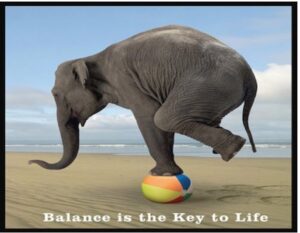
To calm the mind means to find the right balance. If you try to force your mind too much it goes too far; if you don’t try enough it doesn’t get there, it misses the point of balance.
Làm cho tâm vắng lặng có nghĩa là tìm đúng trạng thái quân bình. Nếu cố gắng bắt buộc tâm mình làm việc quá sức, ắt nó đi quá xa. Nếu không cố gắng đầy đủ, nó đi không đến nơi đến chốn, mất thăng bằng.
Normally the mind isn’t still, it’s moving all the time, it lacks strength. Making the mind strong and making the body strong are not the same. To make the body strong we have to exercise it, to push it, in order to make it strong, but to make the mind strong means to make it peaceful, not to go thinking of this and that. For most of us the mind has never been peaceful, it has never had the energy of samàdhi, [1] so we establish it within a boundary. We sit in meditation, staying with the One who knows.
Thông thường, tâm không yên tĩnh ở một nơi luôn luôn chuyển động, nhưng nó kém năng lực. Làm cho tâm có nhiều năng lực và tạo năng lực cho thân không giống nhau. Muốn cho thân có sức mạnh phải thúc đẩy, bắt nó vận động. Nhưng làm cho tâm mạnh có nghĩa là làm cho nó an lạc, không nghĩ ngợi suy tư điều nầy việc nọ. Đối với phần đông chúng ta, tâm không bao giờ an lạc, không bao giờ có được năng lực của “định” (samàdhi) — trạng thái tâm an trụ và tĩnh lặng do pháp môn hành thiền, ở với “người hiểu biết”.

If we force our breath to be too long or too short,
we’re not balanced, the mind won’t become peaceful.
If we force our breath to be too long or too short, we’re not balanced, the mind won’t become peaceful. It’s like when we first start to use a pedal sewing machine. At first, we just practice pedaling the machine to get our co-ordination right, before we actually sew anything. Following the breath is similar. We don’t get concerned over how long or short, weak or strong it is, we just note it. We simply let it be, following the natural breathing.
Nếu ép buộc hơi thở của mình phải quá dài hay quá ngắn, chúng ta sẽ không quân bình, tâm sẽ không an lạc. Cũng như ta bắt đầu xử dụng bàn máy may đạp bằng chân. Trước tiên chỉ tập đạp không cho quen chân, rồi sau đó mới thật sự may món đồ gì. Theo dõi hơi thở cũng dường thế ấy. Không cần phải lo lắng quan tâm đến hơi thở dài hay ngắn, mạnh hay yếu, chỉ ghi nhận. Chỉ để cho hơi thở tự nhiên diễn tiến và ghi nhận diễn tiến tự nhiên ấy.
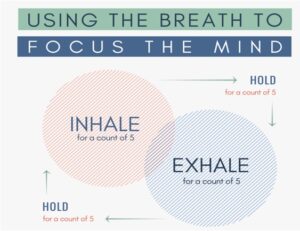
When it’s balanced, we take the breathing as our meditation object.
When it’s balanced, we take the breathing as our meditation object. When we breathe in, the beginning of the breath is at the nose tip, the middle of the breath at the chest and the end of the breath at the abdomen. This is the path of the breath. When we breathe out, the beginning of the breath is at the abdomen, the middle at the chest and [1. Samàdhi is the state of concentrated calm resulting from meditation practice.] the end at the nose tip. We simply take note of this path of the breath at the nose tip, the chest and the abdomen, then at the abdomen, the chest and the tip of the nose. We take note of these three points in order to make the mind firm, to limit mental activity so that mindfulness and self-awareness can easily arise.
Khi hơi thở đều đặn ta sẽ lấy đó làm đề mục hành thiền. Lúc thở vào, đoạn đầu của hơi thở ở tại chót mũi, đoạn giữa tại lồng ngực, và đoạn cuối ở bụng. Đó là con đường của hơi thở. Khi thở ra, đoạn đầu của hơi thở ở bụng, đoạn giữa ở lồng ngực, và đoạn cuối cùng ở chót mũi. Ta chỉ giản dị theo dõi ghi nhận luồng hơi thở ở chót mũi, lồng ngực, và bụng. Rồi bụng, lồng ngực, và chót mũi. Chúng ta ghi nhận ba điểm nầy để làm cho tâm vững chắc, để hạn chế những hoạt động tâm linh nhằm giúp phát sanh dễ dàng tâm chú niệm và tự hay biết mình.

Soon the mind becomes peaceful, the breath refined.
The mind and body become light. This is the right state for the
work of meditation. Không bao lâu tâm trở nên an lạc, hơi thở
trở nên vi tế. Thân tâm nhẹ nhàng. Đó là trạng thái đúng,
trong công phu hành thiền.
When we are adept at noting these three points, we can let them go and note the in and out breathing, concentrating solely at the nose-tip or the upper lip where the air passes on its in and out passage. We don’t have to follow the breath, just establish mindfulness in front of us at the nose-tip, and note the breath at this one point — entering, leaving, entering, leaving. There’s no need to think of any-thing special, just concentrate on this simple task for now, having continuous presence of mind. There’s nothing more to do, just breathing in and out.
Đến lúc đã thuần thục ghi nhận ba điểm nầy, ta có thể không theo dõi hơi thở trọn vẹn từ chót mũi đến bụng nữa mà chỉ chú tâm nơi chót mũi, hoặc ở môi trên, nơi nào mà luồng hơi chạm vào, và chỉ theo dõi hơi thở nơi điểm ấy. Không cần phải đi theo hơi thở, mà chỉ chú niệm vào chót mũi và ghi nhận hơi thở tại ngay điểm duy nhất ấy — vào, ra, vào, ra … Không cần phải suy nghĩ gì đặc biệt. Trong hiện tại chỉ tập trung nỗ lực vào nhiệm vụ đơn giản nầy, luôn luôn có sự chú tâm hay biết. Không có gì khác phải làm, chỉ thở vào, thở ra.
Soon the mind becomes peaceful, the breath refined. The mind and body become light. This is the right state for the work of meditation.
Không bao lâu tâm trở nên an lạc, hơi thở trở nên vi tế. Thân tâm nhẹ nhàng. Đó là trạng thái đúng, trong công phu hành thiền.
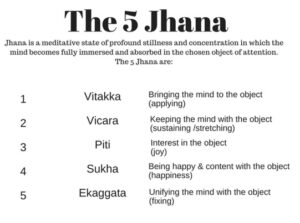
The five Jhana factors – Tầm, Tứ, Hỷ, Lạc, Định
When sitting in meditation the mind becomes refined, but whatever state it’s in we should try to be aware of it, to know it. Mental activity is there together with tranquility. There is vitakka. Vitakka is the action of bringing the mind to the theme of contemplation. If there is not much mindfulness, there will be not much vitakka. Then vicàra, the contemplation around that theme, follows. Various “weak “mental impressions may arise from time to time but our self-awareness is the important thing — whatever may be happening we know it continuously. As we go deeper, we are constantly aware of the state of our meditation, knowing whether or not the mind is firmly established. Thus, both concentration and awareness are present.
Khi ngồi thiền, tâm trở nên vi tế, nhưng bất luận trạng thái tâm như thế nào ta phải cố gắng hay biết, thấu hiểu nó. Sinh hoạt tâm linh cùng ở chung với trạng thái vắng lặng. Có chi thiền Tầm (Vitakka or thought), trạng thái tâm đưa đến đề mục. Nếu niệm (sati) yếu, Tầm (Vitakka) cũng yếu. Rồi tiếp theo đó là chi thiền Sát, hay Tứ (Vicàra or gliding, moving about), tức trạng thái quán niệm quanh quẩn đề mục. Thỉnh thoảng những cảm giác yếu ớt khác nhau có thể phát hiện, nhưng tự hay biết mình là yếu tố quan trọng, bất cứ gì xảy ra, ta liên tục hay biết. Càng đi sâu vào thiền ta càng hay biết thường xuyên trạng thái tâm của ta, thấu hiểu tâm có an trụ vững chắc cùng không. Như vậy cả hai, chú niệm và hay biết đều hiện diện, hành giả luôn luôn chú niệm và hay biết.

Vitakka and vicàra (thought and gliding)

The five Jhana factors – Tầm, Tứ, Hỷ, Lạc, Định. Cả bốn chi
thiền nầy đều nằm chung trong tâm vắng lặng, an trụ vững chắc.
Tất cả cùng ở chung trong một trạng thái. Đó là Nhất Điểm Tâm
(Ekaggatà) gọi chung là “định“- Chi thứ năm của Thiền Chỉ (Samatha).
To have a peaceful mind does not mean that there’s nothing happening, mental impressions do arise. For in-stance, when we talk about the first level of absorption, we say it has five factors. Along with vitakka and vicàra, pìti (rapture) arises with the theme of contemplation and then sukha (happiness). These four things all lie together in the mind established in tranquility. They are as one state.
Tâm an lạc không có nghĩa là không có gì xảy ra, những cảm xúc có thể phát sanh. Thí dụ như khi đề cập đến sơ thiền, tầng vắng lặng đầu tiên, ta nói có năm chi. Cùng với hai chi thiền Tầm và Sát, chi thiền Phỉ (Pìti) cũng phát sanh với đề mục và sau đó là chi thiền Lạc (Sukha). Cả bốn chi thiền nầy đều nằm chung trong tâm vắng lặng, an trụ vững chắc. Tất cả cùng ở chung trong một trạng thái. [1]
The fifth factor is ekaggatà or one-pointedness. You may wonder how there can be one-pointedness when there are all these other factors as well. This is because they all become unified on that foundation of tranquility. Together they are called a state of “samàdhi = định”. They are not everyday states of mind, they are factors of absorption. There are these five characteristics, but they do not disturb the basic tranquility. There is “vitakka = tầm”, but it does not disturb the mind; “vicàra – tứ”, “rapture = hỷ” and “happiness = lạc” arise but do not disturb the mind. The mind is therefore as one with these factors. The first level of absorption is like this.
Chi thứ năm là Nhất Điểm Tâm (Ekaggatà), tâm gom vào một điểm duy nhất. Ta có thể ngạc nhiên, làm sao tâm có thể là “nhất điểm” trong khi còn có những chi thiền khác cùng hiện diện trong một lúc. Đó là vì tất cả đều hợp nhất, an trụ trên nền tảng vắng lặng. Hợp chung lại cả năm chi thiền được gọi chung là “định” (samàdhi). Nó không phải là trạng thái tâm mà ta có hằng ngày, mà là những yếu tố của vắng lặng, các chi thiền. Có năm đặc điểm ấy, nhưng không làm xáo trộn trạng thái vắng lặng căn bản. Có chi Tầm, nhưng nó không khuấy động tâm. Sát, Phỉ, Lạc phát sanh, nhưng không làm xáo trộn tâm. Tâm là một, đồng nhất thể với các chi thiền. Tầng vắng lặng đầu tiên là như vậy.
*** ***
Proto Buddhism – The Original Teaching of the Buddha
By Venerable Dr. Madawela Punnaji Nayaka Maha Thera
Entering Ecstasy
(1) The first ecstasy: with inquiry, inference, serenity, comfort, and stillness of mind.
(2) Then the second ecstasy: with serenity, comfort, and stillness of mind.
(3) Then the third ecstasy: with comfort and stillness of mind.
(4) Then the fourth ecstasy: with stillness and apperception.

The 4 Jhana attainments – Chứng đắc Tứ thiền
Then he began to enter the cognitive ecstasies:
(1) The realm of infinite space
(2) The realm of infinite perception
(3) The realm of nothingness
(4) The realm of neither sensation nor no sensation
(5) The cessation of sensation and feeling.
This last state was the absolute unconsciousness (avijjā), where the consciousness was absent though the body was alive. It was when he woke up from this state that he began to become aware of the mental process by which the “world” that we are aware of, the “self” we are aware of, and the “suffering” we are aware of, came into being. All this came out of the process of perception, conception, cognition, and affection. These psychophysical activities did not arise due to the commandments of a supernatural Creator, but only because of the presence of the necessary conditions.
Trạng thái cuối cùng này là trạng thái vô thức tuyệt đối (avijjā), nơi ý thức vắng mặt mặc dù cơ thể còn sống. Khi thức dậy khỏi trạng thái này, Ngài bắt đầu nhận thức được quá trình tinh thần mà qua đó “thế giới” mà chúng ta nhận thức được, “cái tôi” mà chúng ta nhận thức được và “đau khổ” mà chúng ta nhận thức được, ra đời. Tất cả điều này đến từ quá trình nhận thức, quan niệm, nhận thức và tình cảm. Những hoạt động tâm sinh lý này không phát sinh do lệnh truyền của Đấng Tạo Hóa siêu nhiên, mà chỉ do sự hiện diện của những điều kiện cần thiết.
This experience made him realize that the mind is not an entity separate from the body, but an activity of the body, which when perceived subjectively appears to be mental and when observed objectively appears to be physical. In other words, experience is dichotomized into a subjective and an objective. He also saw that the cognitive process creates the objective “world,” and the affective emotional process creates the subjective “self,” and the resulting suffering.
Kinh nghiệm này khiến Ngài nhận ra rằng tâm trí không phải là một thực thể tách biệt với cơ thể, mà là một hoạt động của cơ thể, khi được nhận thức một cách chủ quan thì có vẻ là tinh thần và khi được quan sát một cách khách quan thì có vẻ là thể chất. Nói cách khác, kinh nghiệm được phân đôi thành chủ quan và khách quan. Ông cũng thấy rằng quá trình nhận thức tạo ra “thế giới” khách quan, và quá trình cảm xúc ái kỷ tạo ra “cái tôi” chủ quan, và kết quả là đau khổ.
*** ***
We don’t have to call it First Jhàna , [2] Second Jhàna, Third Jhàna and so on, let’s just call it “a peaceful mind.” As the mind becomes progressively calmer it will dispense with vitakka and vicàra, leaving only rapture and happiness. Why does the mind discard vitakka and vicàra? This is because, as the mind becomes more refined, the activity of vitakka and vicàra is too coarse to remain. At this stage, as the mind leaves off vitakka and vicàra, feelings of great [2. Jhàna is an advanced state of concentration or samàdhi, where in the mind becomes absorbed into its meditation subject. It is divided into four levels, each level progressively more refined than the previous one] rapture can arise, tears may gush out. But as the samàdhi deepens rapture, too, is discarded, leaving only happiness and one-pointedness, until finally even happiness goes and the mind reaches its greatest refinement. There are only equanimity and one-pointedness, all else has been left behind. The mind stands unmoving.
Chúng ta không cần đề cập đến các tầng Thiền (Jhàna) — sơ thiền, nhị thiền, tam thiền, và tứ thiền — Hãy gọi nó là “tâm an lạc”. Vào lúc trở nên ngày càng vắng lặng hơn, tâm không cần đến Tầm và Sát nữa, mà chỉ còn Phỉ và Lạc. Tại sao tâm loại bỏ Tầm và Sát? Đó là vì khi tâm càng vi tế hơn thì tác động của Tầm và Sát trở thành quá thô thiển để tồn tại chung. Vào giai đoạn nầy, khi tâm loại bỏ Tầm và Sát, những cảm giác phỉ lạc mạnh mẽ có thể phát sanh, nước mắt có thể tuôn chảy. Nhưng khi trạng thái Định vững mạnh sâu sắc thêm, Phỉ cũng bị loại ra, chỉ còn Lạc và Trụ, hay Nhất Điểm Tâm. Cuối cùng, lạc cũng được loại bỏ và tâm tiến đạt đến mức độ vi tế cao nhất, chỉ còn Xả và Nhất Điểm Tâm, tất cả những chi thiền khác đều bị loại. Tâm đứng yên, vững chắc không chao động.
Samadhi is the state of concentrated calm resulting from meditation practice.
Once the mind is peaceful this can happen. You don’t have to think a lot about it, it just happens by itself. This is called the energy of a peaceful mind. In this state the mind is not drowsy; the five hindrances, sense desire, aversion, restlessness, dullness and doubt, have all fled.
Một khi tâm đã an lạc thì điều nầy có thể xảy đến. Quý vị không cần suy tư nhiều về nó, tự nó sẽ đến. Đó là năng lực của tâm an lạc. Trong trạng thái nầy tâm không nghe hôn trầm. Cả năm chướng ngại tinh thần: tham dục, oán ghét, hôn trầm dã dượi, phóng dật lo âu, và hoài nghi đều tan biến.
But if mental energy is still not strong and mindfulness weak, there will occasionally arise intruding mental impressions. The mind is peaceful but it’s as if there’s a “cloudiness” within the calm. It’s not a normal sort of drowsiness though, some impressions will manifest —maybe we’ll hear a sound or see a dog or something. It’s not really clear but it’s not a dream either. This is because these five factors have become unbalanced and weak.
Tuy nhiên, nếu năng lực tinh thần vẫn chưa đủ mạnh và chú niệm còn yếu, đôi khi một vài cảm xúc sẽ lẫn xen vào. Tâm an lạc, nhưng trong sự tĩnh lặng dường như có một trạng thái lu mờ. Mặc dầu vậy, đó không phải là loại hôn trầm bình thường, một vài cảm xúc sẽ biểu hiện — có thể chúng ta nghe một tiếng động hay thấy một vật, con chó hay gì khác. Nó không phải thật sự rõ ràng nhưng cũng không phải là một giấc mơ. Đó là vì năm pháp triền cái không quân bình và còn yếu ớt.
The mind tends to play tricks within these levels of tranquility. “Imagery” will sometimes arise when the mind is in this state, through any of the senses, and the meditator may not be able to tell exactly what is happening. “Am I sleeping? No. Is it a dream? No, it’s not a dream….” These impressions arise from a middling sort of tranquility; but if the mind is truly calm and clear we don’t doubt the various mental impressions or imagery which arise. Questions like, “Did I drift off then? Was I sleeping? did I get lost? …” don’t arise, for they are characteristics of a mind which is still doubting. “Am I asleep or awake?” … Here, it’s fuzzy! This is the mind getting lost in its moods. It’s like the moon going behind a cloud. You can still see the moon but the clouds covering it render it hazy. It’s not liked the moon which has emerged from behind the clouds— clear, sharp and bright.
Tâm có chiều hướng bày trò phỉnh gạt bên trong những tầng vắng lặng. Những hình ảnh tưởng tượng xuyên qua giác quan, đôi khi sẽ phát sanh khi tâm ở vào trạng thái nầy, và hành giả không thể nói một cách chính xác những gì đã xảy ra, “Tôi có đang ngủ chăng? Không. Phải chăng đó là một giấc mơ.” Những cảm giác tương tợ thường phát sanh trong trạng thái vắng lặng; nhưng nếu tâm thật sự vắng lặng và sáng tỏ chúng ta không hoài nghi những cảm giác, hoặc những hình ảnh tưởng tượng khác nhau đã phát sanh. Những thắc mắc như, “Tôi có phóng tâm không? Tôi có ngủ không? Tôi có lạc lối không?” không phát sanh, bởi vì nó là những đặc điểm của cái tâm còn hoài nghi, “Tôi ngủ hay thức? … Đó, nó bị rối nùi! Đó là cái tâm bị lạc lối trong những cảm giác. Giống như ánh trăng bị vầng mây che án. Ta vẫn còn thấy mặt trăng, nhưng nó bị mây án nên trở thành lu mờ. Không phải như mặt trăng đã vượt ra khỏi đám mây — trong sáng, rõ ràng và rạng ngời.
When the mind is peaceful and established firmly in mindfulness and self-awareness, there will be no doubt concerning the various phenomena which we encounter. The mind will truly be beyond the hindrances. We will clearly know as it is everything which arises in the mind. We do not doubt it because the mind is clear and bright. The mind which reaches samàdhi is like this.
Khi tâm an lạc và kiên cố vững chắc trong chú niệm và trong trạng thái tự hay biết, sẽ không còn hoài nghi đối với những hiện tượng khác nhau mà mình gặp phải. Nó sẽ thật sự vượt ra ngoài những chướng ngại tinh thần. Chúng ta sẽ thấu hiểu rõ ràng tất cả những gì phát sanh đến tâm, đúng như chính thật nó là vậy. Chúng ta không hoài nghi bởi vì tâm đã sáng ngời và tỏ rạng. Cái tâm tiến đạt đến “định” (samàdhi) là như vậy.
However, some people find it hard to enter samàdhi because it doesn’t suit their tendencies. There is samàdhi, but it’s not strong or firm. But one can attain peace through the use of wisdom, through contemplating and seeing the truth of things, solving problems that way. This is using wisdom rather than the power of samàdhi.
Tuy nhiên, vài người cảm thấy khó mà nhập định (samàdhi), bởi vì việc nầy không thích hợp với khuynh hướng tự nhiên của họ. Tâm có định, nhưng không đủ dũng mãnh và không đủ kiên cố. Trong trường hợp nầy, có thể thành tựu an lạc bằng cách dùng trí tuệ để quán chiếu và nhận thấy chân lý của sự vật, giải quyết vấn đề như vậy. Đó là xử dụng trí tuệ, thay vì năng lực của định.
To attain calm in practice it’s not necessary to sit in meditation, for instance. Just ask yourself, “Ehh, what is that? …” and solve your problem right there! A person with wisdom is like this. Perhaps he can’t really attain high levels of samàdhi, although he develops some, enough to cultivate wisdom. It’s like the difference between farming rice and farming corn. One can depend on rice more than corn for one’s livelihood. Our practice can be like this, we depend more on wisdom to solve problems. When we see the truth, peace arises.
Trong thực tế, không cần thiết phải ngồi thiền để thành đạt trạng thái vắng lặng. Chỉ tự hỏi mình, “Ê! Cái gì vậy?” và giải quyết vấn đề ngay tại đó! Người có trí tuệ là vậy. Có thể không thật sự đạt đến những tầng cao nhất của tâm định, mặc dầu vậy người ấy cũng phát triển tâm an trụ đầy đủ để trau giồi trí tuệ. Cũng giống như sự khác biệt giữa trồng lúa và trồng bắp. Để sinh sống, người kia có thể tùy thuộc vào lúa nhiều hơn bắp. Pháp hành của chúng ta cũng dường như thế ấy, tùy thuộc nhiều hơn vào trí tuệ để giải quyết vấn đề. Khi đã thấy chân lý, an lạc sẽ phát sanh.
The two ways are not the same. Some people have insight and are strong in wisdom but do not have much samàdhi. When they sit in meditation, they aren’t very peaceful. They tend to think a lot, contemplating this and that, until eventually they contemplate happiness and suffering and see the truth of them. Some incline more towards this than samàdhi. Whether standing, walking, sitting or lying [3], enlightenment of the Dhamma can take place. Through seeing, through relinquishing, they attain peace. They attain peace through knowing the truth without doubt, because they have seen it for themselves.
Hai đường lối nầy không giống nhau. Vài người có tuệ minh sát và trí tuệ dũng mãnh, nhưng không có nhiều tâm định. Khi ngồi xuống hành thiền họ không thấy nhiều an lạc. Họ có khuynh hướng suy tư buông lung, quán tưởng điều nầy việc nọ, cho đến khi tình cờ họ quán niệm về hạnh phúc và đau khổ và thấy chân lý trong đó. Họ thiên về quán chiếu sự vật hơn là định tâm. Bất luận giờ phút nào — trong khi đi, đứng, nằm hay ngồi [3] — ta cũng có thể chứng ngộ Giáo Pháp. Do nhận thấy, do từ bỏ, họ đạt đến an lạc thanh bình. Họ thành tựu trạng thái an lạc bằng cách thấu triệt chân lý mà không chút hoài nghi, bởi vì chính họ đã nhận thấy.
Other people have only little wisdom but their samàdhi is very strong. They can enter very deep samàdhi quickly, but not having much wisdom, they cannot catch their defilements, they don’t know them. They can’t solve their problems.
Người khác, có ít trí tuệ nhưng tâm định rất dũng mãnh. Họ có thể nhập định một cách nhanh chóng và thâm sâu, nhưng không có nhiều trí tuệ. Họ không thể chụp bắt được các ô nhiễm của họ, không nhận biết nó. Họ không thể giải quyết vấn đề.
But regardless of whichever approach we use, we must do away with wrong thinking, leaving only Right View. We must get rid of confusion, leaving only peace.
Nhưng, bất luận đường lối nào đã chọn, ta phải loại bỏ suy tư lầm lạc và chỉ giữ lại chánh kiến. Phải loại trừ tình trạng mơ hồ hỗn loạn, chỉ giữ lại an lạc thanh bình.
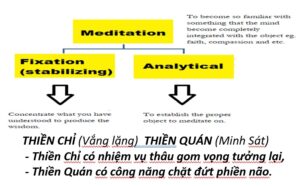
Either way we end up at the same place. There are these two sides to practice, but these two things, calm and insight, go together. We can’t do away with either of them. They must go together.
Đàng nào chúng ta cũng chấm dứt cùng một nơi. Pháp hành có hai mặt, vắng lặng và minh sát, nhưng cả hai cùng hợp chung thành một. Không thể bỏ một trong hai. Nó phải cùng đi chung.
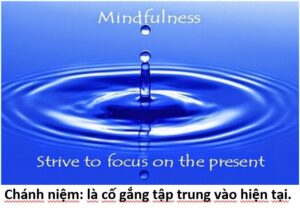
Chánh niệm: là cố gắng tập trung vào hiện tại.
That which “looks over” the various factors which arise in meditation is ‘sati’, mindfulness. This sati is a condition which, through practice, can help other factors to arise. Sati is life. Whenever we don’t have sati, when we are heedless, it’s as if we are dead. If we have no sati, then our speech and actions have no meaning. This sati is simply recollection. [3. That is, at all times, in all activities.]
It’s a cause for the arising of self-awareness and wisdom. Whatever virtues we have cultivated are imperfect if lacking in sati. Sati is that which watches over us while standing, walking, sitting and lying. Even when we are no longer in samàdhi, sati should be present through-out.
Cái gì “canh chừng” những yếu tố khác nhau phát sanh trong lúc hành thiền là sati, niệm. Xuyên qua pháp hành, niệm là điều kiện có thể trợ duyên cho các yếu tố khác khởi sanh. Niệm là sự sống. Bất cứ lúc nào không có niệm, khi ta để tâm buông lung vọng động, thì dường như ta chết. Nếu không có niệm, lời nói và hành động của ta không có ý nghĩa. Niệm ở đây chỉ là sự hiện hữu của tâm. Niệm tạo nhân duyên cho trạng thái tự hay biết và trí tuệ phát sanh. Nếu không có niệm thì bất cứ đức hạnh nào mà ta trau giồi cũng sẽ không toàn hảo. Niệm là cái gì canh chừng chúng ta trong khi đi, đứng, nằm, ngồi. Dầu trong những lúc mà chúng ta không định, phải luôn luôn giữ chánh niệm.
Whatever we do we take care. A sense of shame [4] will arise. We will feel ashamed about the things we do which aren’t correct. As shame increases, our collectedness will increase as well. When collectedness increases, heedlessness will disappear. Even if we don’t sit in meditation, these factors will be present in the mind.
Bất luận gì ta làm, phải thận trọng. Một ý thức hổ thẹn [3] phát sanh. Ta sẽ cảm nghe hổ thẹn vì việc mà ta làm đã tỏ ra là sai lầm. Khi hổ thẹn tăng trưởng, tâm niệm cũng tăng trưởng. Khi tâm niệm tăng trưởng, tâm dể duôi buông lung sẽ tan biến. Dầu không phải lúc ta đang ngồi thiền những yếu tố ấy vẫn hiện hữu trong tâm.

And this arises because of cultivating sati. Develop sati! This is the dhamma which looks over the work we are doing or have done in the past. It has usefulness. We should know ourselves at all times. If we know ourselves like this, right will distinguish itself from wrong, the path will become clear, and cause for all shame will dissolve. Wisdom will arise.
Điều ấy phát sanh bởi vì tâm niệm của ta đã được trau giồi. Hãy phát triển chú niệm! Đó là yếu tố canh chừng, trông nom công việc mà ta đang làm hoặc đã làm trong quá khứ. Nó thật sự là hữu dụng. Chúng ta phải luôn luôn tự hiểu biết mình. Như thế ấy, những gì đúng đắn hay sai lầm sẽ được phân biệt rành mạch, con đường sẽ trở nên tỏ rạng và nguyên nhân sanh hổ thẹn sẽ biến tan. Trí tuệ sẽ bừng dậy.
We can bring the practice all together as morality, concentration and wisdom. To be collected, to be controlled, this is morality. The firm establishing of the mind within that control is concentration. Complete, overall knowledge within the activity in which we are engaged is wisdom. The practice in brief is just morality, concentration and wisdom, or in other words, the path. There is no other way.
Chúng ta có thể gom chung pháp hành lại trong ba pháp tu học: Giới, Định, Tuệ. Trầm tĩnh tự kiểm soát là Giới. Kiên trì củng cố tâm vững chắc trong khuôn khổ của sự kiểm soát ấy là Định. Thấu hiểu trọn vẹn, tận tường và rành mạch trong mọi sinh hoạt là Tuệ. Tóm tắt, pháp hành chỉ là Giới, Định, Tuệ, hoặc nói cách khác, là Con Đường. Không có đường lối nào khác.
Sources:
Tài liệu tham khảo:
- https://tienvnguyen.net/p154a3371/huong-vi-giai-thoat-a-taste-of-freedom
- https://tienvnguyen.net/images/file/Ng-dFdWa1wgQAF4F/atasteoffreedom.pdf
- https://www.amazon.com/Taste-Freedom-Venerable-Ajahn-Bodhinyana/dp/9552400333
- https://thuvienhoasen.org/a27883/10-chung-dac-giac-ngo
- https://www.budsas.org/uni/u-ngan/giaithoat-01.htm
- Photo 1: https://www.dhammatalks.net/Books/Ajahn_Chah_On_Meditation.htm
- Photo 2: https://www.yogapedia.com/definition/6245/sati
- Photo 3: https://medium.com/digital-cultures/is-the-definition-of-reality-post-modernism-42ab053e43d3
- Photo 4: https://www.sharirozansky.com/personal-nutrition-coach/
- Photo 5: https://duyendangvietnam.net.vn/dang-dep-hon-voi-nhung-bai-tap-sieu-don-gian.html
- Photo 6: https://neurohacker.com/breathing-technique-focus-mind
- Photo 7: https://tableforchange.com/yoga-quotes/
- Photo 8:http://pmpagm.blogspot.com/2018/07/jhanas-x-medittv-states.html
- Photo 9:https://theravadin.wordpress.com/2008/03/23/vitakka-vicara-what-do-they-mean/
- Photo 9a: http://evdhamma.org/index.php/buddhist-study/buddhist-study-3/item/419-bai-so-31-chu-phat-song-ngu
- Photo 10: https://buddhaoriginalteachings.blogspot.com/p/blog-page_85.html
- Photo 11: http://evdhamma.org/index.php/documents/thien-tacgia-va-baiviet/item/1285-thien-la-gi-song-ngu
- Photo 12: https://www.cucmatters.org/2015/03/cultivate-mindfulness.html
- Photo 13: https://www.facebook.com/BuddhistBootCamp/photos/a.1403050856449975/3613402022081503/?type=3
